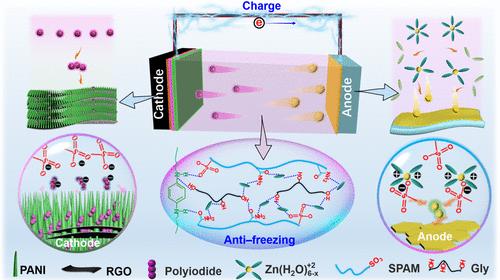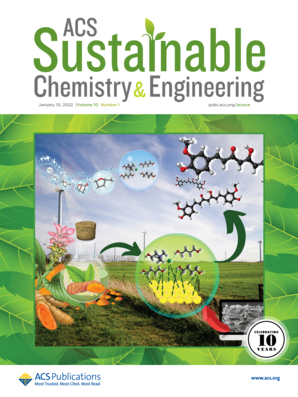Synergistic Construction of Hierarchical Tree-Ring Structures and Blocked Interfaces for Stable, Flexible Zinc–Iodine Batteries with Ultrahigh Areal/Gravimetric Capacity
IF 7.1
1区 化学
Q1 CHEMISTRY, MULTIDISCIPLINARY
引用次数: 0
Abstract
The development of aqueous zinc–iodine (Zn–I2) batteries is plagued by long-term cycling stability, mainly caused by limited iodine loading, polyiodide shuttle, and uneven Zn2+ deposition. Herein, a unique tree-ring-like hierarchical structure constructed by polyaniline (PANI) nanofiber arrays and reduced graphene oxide (RGO) was designed to provide the nanopore array for prestoring iodine ions and confine the iodine conversion reaction as well as promote electron and ion transport along PANI nanofibers, thereby enhancing the capacity and cycling durability of Zn–I2 batteries. Meanwhile, the sulfonic polyacrylamide/glycerol (SPAM/Gly) hydrogel electrolyte containing the ZnI2 additive is introduced for simultaneously inhibiting the polyiodide shuttle and side reactions on the Zn anode accompanied by excellent antifreezing properties and flexibility. As a result, the assembled flexible battery realized a remarkable areal capacity of 2.3 mAh·cm–2 at 0.5 mA·cm–2 (corresponding to 287.5 mAh·g–1) and a maximum energy density of 2.54 mWh·cm–2 at a high mass loading of 8 mg·cm–2. Consequently, the battery still exhibited a capacity of 0.784 mAh·cm–2 over 6000 cycles and 0.98 mAh·cm–2 after 200 cycles under −20 °C at 2 mA·cm–2. Such flexible device also maintains a steady supply of powering electronic gadget during deformations.

协同构建分层树环结构和阻塞界面,实现具有超高面积/重力容量的稳定柔性锌碘电池
锌碘水溶液(Zn-I2)电池的开发受到长期循环稳定性的困扰,这主要是由有限的碘负载、聚碘穿梭和不均匀的 Zn2+ 沉积造成的。本文设计了一种由聚苯胺(PANI)纳米纤维阵列和还原氧化石墨烯(RGO)构建的独特树环状分层结构,为碘离子的预存储提供纳米孔阵列,并限制碘转化反应以及促进电子和离子沿 PANI 纳米纤维的传输,从而提高 Zn-I2 电池的容量和循环耐久性。同时,引入含有 ZnI2 添加剂的磺酸基聚丙烯酰胺/甘油(SPAM/Gly)水凝胶电解质,可同时抑制多碘化物在锌阳极上的穿梭和副反应,并具有优异的防冻性能和柔韧性。因此,组装后的柔性电池在 0.5 mA-cm-2(相当于 287.5 mAh-g-1)的条件下实现了 2.3 mAh-cm-2 的显著磁场容量,在 8 mg-cm-2 的高负载条件下实现了 2.54 mWh-cm-2 的最大能量密度。因此,该电池在 6000 次循环后仍显示出 0.784 mAh-cm-2 的容量,在 2 mA-cm-2 的条件下于 -20 °C 下循环 200 次后仍显示出 0.98 mAh-cm-2 的容量。这种柔性装置还能在变形过程中为电子设备稳定供电。
本文章由计算机程序翻译,如有差异,请以英文原文为准。
求助全文
约1分钟内获得全文
求助全文
来源期刊

ACS Sustainable Chemistry & Engineering
CHEMISTRY, MULTIDISCIPLINARY-ENGINEERING, CHEMICAL
CiteScore
13.80
自引率
4.80%
发文量
1470
审稿时长
1.7 months
期刊介绍:
ACS Sustainable Chemistry & Engineering is a prestigious weekly peer-reviewed scientific journal published by the American Chemical Society. Dedicated to advancing the principles of green chemistry and green engineering, it covers a wide array of research topics including green chemistry, green engineering, biomass, alternative energy, and life cycle assessment.
The journal welcomes submissions in various formats, including Letters, Articles, Features, and Perspectives (Reviews), that address the challenges of sustainability in the chemical enterprise and contribute to the advancement of sustainable practices. Join us in shaping the future of sustainable chemistry and engineering.
 求助内容:
求助内容: 应助结果提醒方式:
应助结果提醒方式:


